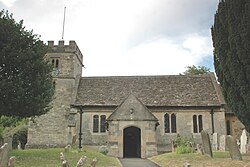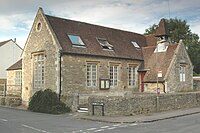Marston, Oxfordshire
| Marston | |
| Oxfordshire | |
|---|---|
 St Nicholas, Marston | |
| Location | |
| Grid reference: | SP5208 |
| Data | |
| Population: | 3,398 (2011) |
| Post town: | Oxford |
| Postcode: | OX3 |
| Dialling code: | 01865 |
| Local Government | |
| Council: | Oxford |
| Parliamentary constituency: |
Oxford East |
| Website: | Old Marston Parish Council |
Marston is a village in Oxfordshire, two miles north-east of the centre of Oxford. It is commonly called Old Marston to distinguish it from the suburb of New Marston that developed between St Clement's and the village in the 19th and 20th centuries. The A40 Northern Bypass, part of the Oxford Ring Road forms a long north-west boundary of the village and parish and a limb, namely a distributary, of the Cherwell forms the western boundary.
History
The name of the village is said to come from "Marsh-town", because of the low-lying nature of the land, still green space, near the River Cherwell, which in earlier times was liable to frequent flooding. The parish used to be part of the manor of Headington.
The Church of England parish church, St Nicholas, began as a chapel, first mentioned in a charter of 1122 by which it was granted to the Augustinians canons of St Frideswide's Priory. The building dates from the 12th century, and has substantial additions in the 15th century.
The village played an important part in the Civil War, during the Siege of Oxford. While the Royalist forces were besieged in the city, which had been used by King Charles I as his capital, the Parliamentary forces under Sir Thomas Fairfax had quarters in Marston, and used the church tower as a lookout post for viewing the enemy's artillery positions in what is now the University Parks. Oliver Cromwell visited Fairfax at Manor House, which is now known as "Cromwell House" at 17 Mill Lane, and "Manor House" at 15 Mill Lane, and the Treaty for the Surrender of Oxford was signed there in 1646.
In the 20th-century expansion of Oxford, new housing followed the Marston Road from St Clement's towards Marston, which was soon absorbed by the city.
About the village
A cycle route links Marston with central Oxford by way of the meadows west of New Marston, over a bridge on the River Cherwell. It is also possible to walk on footpaths across the meadows to the Parks, either by way of the Mesopotamia Walk or Rainbow Bridge.
Outside links
| ("Wikimedia Commons" has material about Marston, Oxfordshire) |
- Blue plaque marks Civil War surrender Oxford Mail article on 19 June 2013
References
- A History of the County of Oxford - Volume 5 pp 214-221: Parishes: Marston (Victoria County History)
- Nikolaus Pevsner: The Buildings of England: Oxfordshire, 1974 Penguin Books ISBN 978-0-300-09639-2
